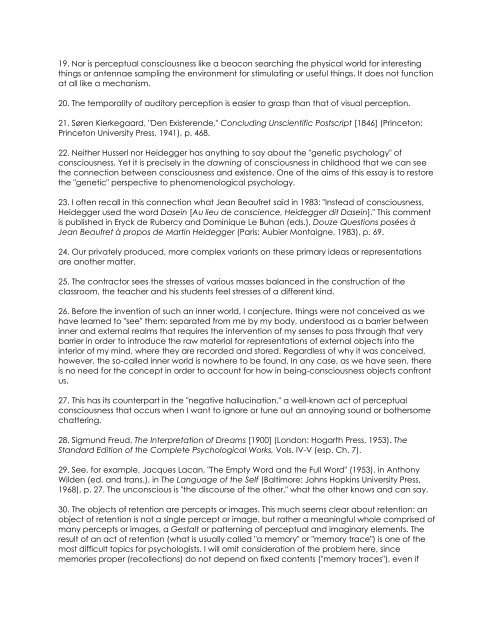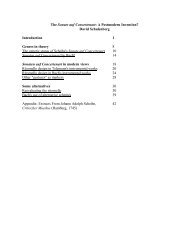SEVEN PAPERS ON EXISTENTIAL ANALYSIS ... - Wagner College
SEVEN PAPERS ON EXISTENTIAL ANALYSIS ... - Wagner College
SEVEN PAPERS ON EXISTENTIAL ANALYSIS ... - Wagner College
Create successful ePaper yourself
Turn your PDF publications into a flip-book with our unique Google optimized e-Paper software.
19. Nor is perceptual consciousness like a beacon searching the physical world for interesting<br />
things or antennae sampling the environment for stimulating or useful things. It does not function<br />
at all like a mechanism.<br />
20. The temporality of auditory perception is easier to grasp than that of visual perception.<br />
21. Søren Kierkegaard, "Den Existerende," Concluding Unscientific Postscript [1846] (Princeton:<br />
Princeton University Press, 1941), p. 468.<br />
22. Neither Husserl nor Heidegger has anything to say about the "genetic psychology" of<br />
consciousness. Yet it is precisely in the dawning of consciousness in childhood that we can see<br />
the connection between consciousness and existence. One of the aims of this essay is to restore<br />
the "genetic" perspective to phenomenological psychology.<br />
23. I often recall in this connection what Jean Beaufret said in 1983: "Instead of consciousness,<br />
Heidegger used the word Dasein [Au lieu de conscience, Heidegger dit Dasein]." This comment<br />
is published in Eryck de Rubercy and Dominique Le Buhan (eds.), Douze Questions posées à<br />
Jean Beaufret à propos de Martin Heidegger (Paris: Aubier Montaigne, 1983), p. 69.<br />
24. Our privately produced, more complex variants on these primary ideas or representations<br />
are another matter.<br />
25. The contractor sees the stresses of various masses balanced in the construction of the<br />
classroom, the teacher and his students feel stresses of a different kind.<br />
26. Before the invention of such an inner world, I conjecture, things were not conceived as we<br />
have learned to "see" them: separated from me by my body, understood as a barrier between<br />
inner and external realms that requires the intervention of my senses to pass through that very<br />
barrier in order to introduce the raw material for representations of external objects into the<br />
interior of my mind, where they are recorded and stored. Regardless of why it was conceived,<br />
however, the so-called inner world is nowhere to be found. In any case, as we have seen, there<br />
is no need for the concept in order to account for how in being-consciousness objects confront<br />
us.<br />
27. This has its counterpart in the "negative hallucination," a well-known act of perceptual<br />
consciousness that occurs when I want to ignore or tune out an annoying sound or bothersome<br />
chattering.<br />
28. Sigmund Freud, The Interpretation of Dreams [1900] (London: Hogarth Press, 1953). The<br />
Standard Edition of the Complete Psychological Works, Vols. IV-V (esp. Ch. 7).<br />
29. See, for example, Jacques Lacan, "The Empty Word and the Full Word" (1953), in Anthony<br />
Wilden (ed. and trans.), in The Language of the Self (Baltimore: Johns Hopkins University Press,<br />
1968), p. 27. The unconscious is "the discourse of the other," what the other knows and can say.<br />
30. The objects of retention are percepts or images. This much seems clear about retention: an<br />
object of retention is not a single percept or image, but rather a meaningful whole comprised of<br />
many percepts or images, a Gestalt or patterning of perceptual and imaginary elements. The<br />
result of an act of retention (what is usually called "a memory" or "memory trace") is one of the<br />
most difficult topics for psychologists. I will omit consideration of the problem here, since<br />
memories proper (recollections) do not depend on fixed contents ("memory traces"), even if















